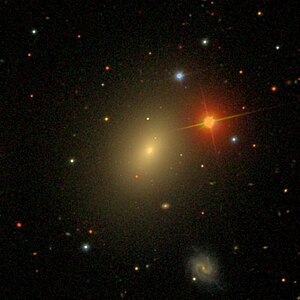NGC 7454
| Galaxy NGC 7454 |
|
|---|---|

|
|
| NGC 7454 with LEDA 214895 (below), SDSS image | |
| AladinLite | |
| Constellation | Pegasus |
|
Position equinox : J2000.0 , epoch : J2000.0 |
|
| Right ascension | 23 h 01 m 06.6 s |
| declination | + 16 ° 23 ′ 21 ″ |
| Appearance | |
| Morphological type | E4? |
| Brightness (visual) | 11.8 mag |
| Brightness (B-band) | 12.8 mag |
| Angular expansion | 2.2 '× 1.6' |
| Position angle | 150 ° |
| Surface brightness | 13.2 mag / arcmin² |
| Physical data | |
| Affiliation | LGG 469 |
| Redshift | 0.006738 ± 0.000017 |
| Radial velocity | 2020 ± 5 km / s |
|
Stroke distance v rad / H 0 |
(98 ± 7) · 10 6 ly (30.1 ± 2.1) Mpc |
| history | |
| discovery | William Herschel |
| Discovery date | October 15, 1784 |
| Catalog names | |
| NGC 7454 • UGC 12305 • PGC 70264 • CGCG 453-045 • MCG + 03-58-020 • 2MASX J23010651 + 1623181 • GC 4880 • H II 249 • LDCE 1553 NED002 | |
NGC 7454 is an elliptical galaxy of Hubble type E4 in the constellation Pegasus at the northern sky . It is estimated to be 98 million light-years from the Milky Way and about 65,000 light-years across.
The galaxies NGC 7448 , NGC 7463 , NGC 7464 , NGC 7468 are in the same area of the sky .
The object was discovered by William Herschel on October 15, 1784 .
